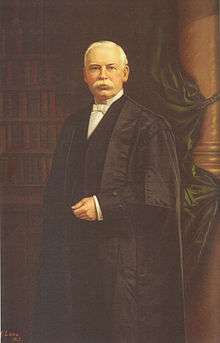James Hamilton Ross
| James H. Ross | |
|---|---|
 | |
| Speaker of the Legislative Assembly of the North-West Territories | |
|
In office 1891–1894 | |
| Preceded by | Herbert Charles Wilson |
| Succeeded by | John Felton Betts |
| Personal details | |
| Born |
May 12, 1856 London, Canada West |
| Died |
December 14, 1932 (aged 76) Victoria, British Columbia |
| Political party | Liberal Party of Canada |
| Spouse(s) | Barbara Elizabeth McKay (m. ca. 1885 - 1901, hear death) |
| Children |
Mary Hathern Ross Jane Graeme Ross John Gordon Ross Christina Graeme Ross James Hamilton Ross Barbara Elizabeth Ross William McKay Ross |
James Hamilton Ross (May 12, 1856 – December 14, 1932) was a Canadian politician, the Yukon Territory's third Commissioner, and an ardent defender of territorial rights. He is also considered to be the first resident of Moose Jaw, Saskatchewan.
Early life
Ross was born in 1856 to John Edgar Ross and Christina Graeme (Hathern) Ross. On January 2, 1882, Ross, a western Canadian rancher born in London, Canada West, and four other men were scouting the location for the Canadian Pacific Railway divisional point when they became the first residents of the modern-day town of Moose Jaw, Saskatchewan.
Four days later, Ross established a homestead on the site, becoming the town's first permanent resident.
Territorial political career
Soon after, Ross became an active participant in territorial government. He continuously campaigned for responsible government and was active in the negotiations to create the provinces of Alberta and Saskatchewan.
Ross sat in the Legislative Assembly of the Northwest Territories between 1883 and 1901, and was Speaker from 1891 to 1894 and a member of the Executive Council between 1895 and 1897. Ross also served as treasurer and then became the Commissioner of the Yukon Territory on March 11, 1901, becoming the first Yukon Commissioner to reside in Government House in Dawson City.
Personal life and family
On August 15, 1901 his wife and youngest son, William, were lost in the sinking of the SS Islander near Juneau.[1]
Another of his daughters, Jane Ross, married Alistair Fraser, the son of Lieutenant-Governor of Nova Scotia Duncan Cameron Fraser, who later went on to become Lieutenant-Governor in his own right.
His son, James Hamilton Ross, a chemist at McGill University, developed and patented a new method of synthesizing RDX used by the Allies in the Second World War. He was awarded the Medal of Freedom as well as Member of the Order of the British Empire.
Federal political career
Ross ran for a seat to the Canadian House of Commons in a by-election held on December 2, 1902. He became the Yukon's first Member of Parliament defeating Yukon territorial councilor Joseph Clarke.[2] He did not visit the Yukon Territory during the campaign and incurred no election expenses other than his deposit.[3]
Ross was appointed to the Senate in 1904. Between 1904 and 1905, Ross represented Regina, Northwest Territories and after 1905 until his death, he continued to represent Regina after the creation of the province of Saskatchewan. From 1902 until his death, Ross was a member of the Liberal Party caucus.
James Hamilton Ross died in 1932 in Victoria, British Columbia.
References
- ↑ "Loss of a Liner". The Times (36538). London. 20 August 1901. p. 8.
- ↑ "Yukon election results". Parliament of Canada. December 2, 1902. Retrieved December 16, 2010.
- ↑ "Expenses of Election". Vol III No. 42. The Yukon Sun. February 17, 1903. p. 2.
External links
- James Hamilton Ross Encyclopedia of Canada
- James Hamilton Ross - Canadian Confederation at www.collectionscanada.ca
| Legislative Assembly of the Northwest Territories | ||
|---|---|---|
| New constituency | Member of the Legislative Assembly of the Northwest Territories for Moose Jaw 1883–1901 |
Succeeded by George Annable |
| Preceded by Herbert Charles Wilson |
Speaker of the Legislative Assembly of the Northwest Territories 1891–1894 |
Succeeded by John Betts |
| Parliament of Canada | ||
| New constituency | Member of Parliament for Yukon 1902–1904 |
Succeeded by Alfred Thompson |
| Government offices | ||
| Preceded by William Ogilvie |
Commissioner of Yukon 1901–1902 |
Succeeded by Frederick Tennyson Congdon |